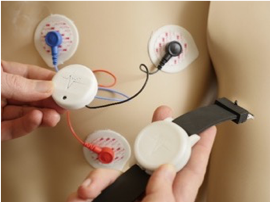Physiological Sensors

ASSIST is developing technologies that enable exposure-related respiratory and cardiac health management, glycemic index management, and medication compliance through continuous monitoring of parameters including ECG, heart rate, heart rate variability, arterial oxygen saturation, and estimation of blood pressure.
While photonic measurements, including photoplethysmogram (PPG) and pulse oximetry, are among the most common methods of tracking physiology in wearable systems, they are also the most power-hungry. The primary challenges in this space involve lowering the power consumption of these methodologies, improving the flexibility/wearability of devices, as well as exploring emerging/novel organic devices for biophotonic applications. In the area of ECG measurement, the challenges involve both wearability and manufacturability (textile-embedded dry electrodes) as well as exploring alternative sensing locations (ECG on the arm).
The ASSIST PPG system has demonstrated the lowest power consumption to date as a result of on-board compressed sensing capability. This system is integrated into both the chest-patch and wrist-band form factors and is undergoing testing in controlled clinical environments as part of ASSIST’s Wearable System for Asthma Monitoring. In an effort to improve the wearability and flexibility of these form factors, ongoing research also aims at improving organic light-emitting diode and photodiode technologies as well as stretchable ad flexible substrates for circuit board fabrication.
ASSIST has also developed dry electrodes and interconnects integrated with the Self-Powered ECG Shirt. By combining Inkjet printing of particle-free conductive inks with innovative Kirigami designs, these technologies aim to reduce motion artifacts and improve wearability, performance, and manufacturability of these textiles. Finally, ASSIST has successfully demonstrated and is currently conducting clinical testing of an ECG armband, which eliminates the need for electrodes on the chest.
